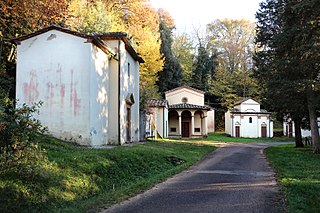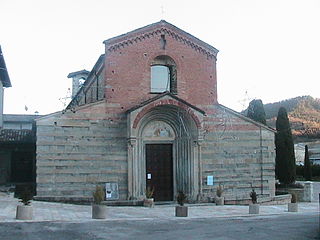
The Order of Friars Minor Capuchin is a religious order of Franciscan friars within the Catholic Church, one of two "First Orders" that sprang from the Franciscan Friars Minor Observant, the other being the Conventuals. The Capuchins arose in 1525 with the purpose of returning to a stricter observance of the rule established by Francis of Assisi in 1209.

The Poor Clares, officially the Order of Saint Clare – originally referred to as the Order of Poor Ladies, and later the Clarisses, the Minoresses, the Franciscan Clarist Order, and the Second Order of Saint Francis – are members of a contemplative Order of nuns in the Catholic Church. The Poor Clares were the second Franciscan branch of the order to be established. Founded by Saints Clare of Assisi and Francis of Assisi on Palm Sunday in the year 1212, they were organized after the Order of Friars Minor, and before the Third Order of Saint Francis for the laity. As of 2011, there were over 20,000 Poor Clare nuns in over 75 countries throughout the world. They follow several different observances and are organized into federations.

Mendicant orders are, primarily, certain Christian religious orders that have adopted a lifestyle of poverty, traveling, and living in urban areas for purposes of preaching, evangelization, and ministry, especially to the poor. At their foundation these orders rejected the previously established monastic model. This model prescribed living in one stable, isolated community where members worked at a trade and owned property in common, including land, buildings and other wealth. By contrast, the mendicants avoided owning property at all, did not work at a trade, and embraced a poor, often itinerant lifestyle. They depended for their survival on the goodwill of the people to whom they preached.

Basílica y Convento de San Francisco is the Spanish name for Saint Francis Monastery located in Lima, Peru, south of Parque la Muralla and one block northeast from the Plaza Mayor, Lima. The church and convent are part of the Historic Centre of Lima, which was added to the UNESCO World Heritage List in 1991. Aside from a church and monastery it also contains a library and catacombs. In this church, Jude the Apostle is venerated. At the feast of Saint Jude Tadeus a one and a half ton weighing silver stand is carried round in procession by 40 people, starting from the convent.

Porziuncola, also called Portiuncula or Porzioncula, is a small Catholic church located within the Papal Basilica of Saint Mary of the Angels in Assisi in the frazione of Santa Maria degli Angeli, situated about 4 kilometres (2.5 mi) from Assisi, Umbria. It is the place from where the Franciscan movement started.

Pantasaph is a small village in Flintshire, north-east Wales, two miles south of Holywell in the community of Whitford. Its name translates into English as Asaph's Hollow.
The Basilica of San Nicandro is a medieval Roman Catholic church in town of Venafro, in the Region of Molise.

The Convent de Le Celle is a 13th-century Franciscan Convent located in Le Celle, just outside Cortona, region of Tuscany, Italy. It is also referred to as the Convento delle Celle or Eremo Le Celle.

San Vivaldo Monastery is a Roman Catholic convent, church, and sanctuary complex located outside of the town of Montaione, region of Tuscany, Italy. The eighteen distinct chapels on this hill, putatively corresponding to sites of the Holy Land, and containing vivid polychrome statuary groupings recalling events of the New Testament, specially the Passion of Jesus, are one of the few examples of the Sacri Monti complexes in Tuscany. Sacri Monti are more characteristic expressions of veneration in the Piedmont and Lombardy. The convent still houses the franciscan order.

The Chiesa dei Cappuccini or Church of the Capuchin Monks is a Romanesque style, Roman Catholic church in the town of Varzi, province of Pavia, region of Lombardy, Italy.
The parish church of San Francesco d'Assisi and its adjacent Capuchin convent are located in the outskirts of Lecco, region of Lombardy, Italy.
San Torpé is a Roman Catholic church located in Largo del Parlascio #20 in the town of Pisa, region of Tuscany, Italy.
The Convento di Colfano of Convento di San Francesco di Colfano is a Franciscan order, Roman Catholic convent and church located in a rural site just off National road 502 outside of the town of Camporotondo di Fiastrone, province of Macerata, region of Marche, Italy.

The Convento de Santa Clara la Real is a convent of the Poor Clares located in the city of Toledo, Castile-La Mancha, Spain. The present convent was founded in the middle of the 14th century by Toledan noblewoman María Meléndez, and is located near other monasteries of note, such as the monastery of Santo Domingo el Real and the Convent of Capuchins of Toledo.

Santa Chiara is a Roman Catholic church located on Via Barbacana, 49 in the town of Bra, province of Cuneo, region of Piedmont, northern Italy. The small domed church was designed by the late-Baroque architect Bernardo Antonio Vittone.

Sant’Andrea is a 14th-century church located in Spello, province of Perugia, region of Umbria, Italy.

Santa Lucia is a Baroque-style, former-Roman Catholic church and the adjacent convent is located on Vicolo Santa Lucia #8 in the medieval center of the city of Rieti, region of Lazio, Italy. The church now mainly celebrates Roman Orthodox rites. The convent in 2020 houses the archaeologic collections of the Museo Civici of Rieti.
San Paolo is a Roman Catholic church and former monastery in the town of Poggio Nativo, province of Rieti, Region of Lazio, Italy.
San Francesco d'Assisi is a Roman Catholic church in the town of Calascibetta, in the region of Sicily, Italy.













